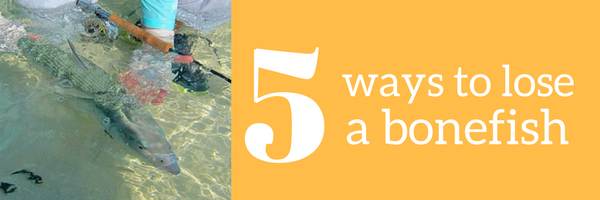Hooking a bonefish is rarely an easy feat.
These fish are crafty, they spook easily, and they’re often difficult to spot. Once you’ve finally gotten a big bone on your hook, failing to bring him in is nothing less than heartbreaking. Following are five ways to break off a bonefish, along with a few tips for ensuring a seamless catch.
1. Keeping Your Eye On The Prize
Your first instinct after you’ve hooked a bone is to follow him with your eyes. Although this often feels very natural and right, it’s one of the worst mistakes that you can make. Most bones will react to getting hooked with a few seconds of stunned surprise. Immediately after this, however, they’re going to take off as quickly as they can. Your job is to make sure that your line is clear and free of any obstructions. Spending too much time ogling the catch that you have yet to actually bring in is a sure way to miss out.
2. Failing To Clear Your Line
Make sure that the fly line hasn’t unexpectedly shifted underfoot. If it has, the leader won’t bear up under your weight for very long. You also have to make sure that any loose line around your feet can flow nicely through the rod guides without tangling up. Separate your hands and then use your rod hand to keep the fighting butt firmly against your wrist. This way, the line won’t have the chance to loop around the butt. You also want to avoid keeping the rod tip too high. Maintaining a more moderate angle will prevent the rod from throbbing back and forth, and give you more control as you feed the line out.
3. Getting Snagged On Mangrove Shoots And Coral
Most flat bottoms are far from being entirely smooth, sandy surfaces. Instead, patch coral cover portions of these, providing plenty of rough and sharp areas that can snag your line or leader and break the fish off. To prevent a bone from dragging your leader across these sharp edges, lift your rod sufficiently high as soon as the fish starts running. This will keep the line clear until you’re able to reel him in. When your fish darts off into the mangroves, take all the pressure off of your drag and the fish will stop to fight. Keep the pressure on and the fish will go against the tension of the drag deep into the mangroves. Thus scarring up the fly-line, ruining the leader and most likely the demise of the fish. Once the fish stops running you can usually reel him in or pursue him on foot and can assume a much more advantageous, fighting position.
4. Fly And Leader Damage
Having your leader get raked across sharp edges under water is not the only equipment damage you have to think about. Broken hooks have been responsible for a number of devastating losses out on the flats. Among the most common causes for this issue are flies that have been fished in saltwater before, and then simply packed away for reuse. Keep in mind that saltwater has a tendency to break just about everything down, and this includes stainless, saltwater hooks. Even rinsing these off in clean, fresh water won’t restore their initial integrity. Once you’ve fished with a fly in saltwater, go ahead and toss it out at the end of your trip. Diligently replacing these is the best way to avoid broken hooks, right when you need your flies to stand up to a fight.
You should also take the time to check the leader after every fish. Snapper and barracuda have sharp teeth that can break your leader down and cause it to fail. Immediately after unhooking a barracuda or snapper, take a few minutes to make sure that your leader is fully intact.
5. Holding On To Your Hook Set For Too Long
One sure way to break a bone off is by holding your hook set for too long. As soon as the fish runs, which won’t take long at all, you have to take action. Keep in mind that even very small bones can be surprisingly powerful when they want to get away, and thus, if you aren’t feeding them sufficient line when they’re in motion, you’re guaranteed to hear that heartbreaking, popping sound as your line snaps.









